#There's plenty more but those are the most prominent examples
Explore tagged Tumblr posts
Text
Love when I go through a tag for one of my favourite characters and it ends up just being an extensive block list :/
#Wyll Ravengard#Ada Wong#Mia Winters#I promise I'm not spam tagging. this post is specifically about them.#There's plenty more but those are the most prominent examples#I wonder what these characters have in common that the fandoms are so utterly brain dead when it comes to them...#Surely it's not- no it couldn't possibly be-#resident evil#Bg3#Fandom
12 notes
·
View notes
Text
hot take: the problem with doctor who is NOT that they brought billie piper back, it is NOT that ncuti left early, it is NOT that 15 never faced a dalek or a cyberman, and it is CERTAINLY NOT that it’s ’too woke’
the problem with doctor who is that they have forgotten how to engage an audience without utterly confusing them. if i were a writer, this is what i’d change:
1. i would lower the stakes
my biggest issue with dw in recent years is that the stakes are always SO high - it’s always ‘we need to sort this out or else the ENTIRE UNIVERSE WILL END. this rarely happened at the start of nuwho. of course, there were instances where galaxies and universes were at stake, but there were also plenty of instances where the doctor solves issues to A. save his own skin, B. save his friends, and C. to save smaller populations of people and/or generally do what is morally right.
prime example is in new earth. the world isn’t really at stake, he has a couple of objectives: get cassandra to piss off, free the test subjects, stop the infections from spreading. he doesn’t spend the hour worrying that if he doesn’t help then the world will end, he sees a problem that’s morally corrupt and he solves it for the sake of that group. the payoff is just as good, and actually IMPROVES the payoff for episodes where a bit more is at stake, like the poison sky, for example.
2. i would stop plots from spilling over across seasons
i’d like to remind everyone that, although there were things that kind of linked into each other and were mentioned again, generally for the first 4 seasons of (new) doctor who, an overarching issue was built up, climaxed, and resolved throughout a single season. for example: bad wolf in s1. this has gotten worse and worse over time but has honestly been a problem since rtd1 ended, and for some reason when he came back it got WORSE than it’s ever been!!! there’s just way too much overspill across seasons, things even span accross different doctors more recently which is just too much at times. when it’s little things it doesn’t matter, but it’s not. again, this has been an issue before this finale, but this finale is a good example since there were a hundred and one loose ends before he regenerated. when nuwho began, they literally stated each regen would be treated as a soft reboot and their neglect of that has been a downfall.
3. i’d make doctor who dirty and grungy again
it’s too clean futuristic ultra modern sci-fi these days. the tardis doesn’t look like he stole it. what happened to those fun tardis scenes where the entire thing would shake as it took off and landed? why is everything so light and clean? it should be dim and cozy and imperfect.
4. i’d make the companions’ family members more prominent and interesting characters again
doesn’t take much explaining, really. picture jackie tyler, now picture carla sunday. who has a stronger presence and personality in your head and why is it jackie tyler? (there’s bound to be someone who disagrees and that’s fine but i don’t rlly want to hear about it tbh)
5. i’d re-inject some british whimsy
please don’t mistake this as me saying doctor who ‘isn’t british’ or something weird and gammon-y like that, i love when dw explores different cultures, the story and the engine was one of my highlights last season, i just mean like - let him save the world with a jammy dodger again. let him be brought back to life by a good cup of tea. it makes it enjoyable.
there are lots of things, but those are my main ones.
EDIT: thank you to everyone who has weighed in on this - i’ve found it really interesting to see everyone’s perspectives on this because honestly i could talk for king and country about it, but also i just wanted to say that it makes me kind of sad that one of my only negative posts about doctor who is my most popular post :( if you’re reading this, it’s your sign to do something positive today, if i can help to make just one person’s day better then that’s a win to me :)
#doctor who#whoniverse#bbc doctor who#the reality war#dw#nuwho#fifteenth doctor#15th doctor#ncuti gatwa
2K notes
·
View notes
Text


haha okay okay, I'll share my thoughts (this got long whoops. lots to cover)
first of all, just to clear I'm not saying that I think toby is trying to make the fanbase assume wholesomeness in EVERY relationship he writes, or even every lesbian relationship. I don't think he did that for alphyne, I think that is just a genuinely wholesome relationship for the most part. they have some stuff to work out (mostly based around alphys' lying and insecurities) but what couple doesnt? I did theorize that toby might have kept that in mind while writing suselle specifically though, given the surface-level similarities to alphyne (which essentially just boil down to 'tough girl x shy girl'). considering that toby's been developing noelle and susie since at least 2015 I doubt that's where he started out with the two of them, but I think it's plausible it influenced how he chose to frame their scenes in the final product.
I haven't seen whatever post you're talking about discussing alphyne vs RG01/RG02, and to be frank I don't remember seeing a lot of art of the knights that was overly sexual as opposed to just cute. I do believe that there's some level of it that I just haven't encountered but I don't know if it was the best example to illustrate this point. it IS true though that when it comes to shipping, there's a trend of viewing relationships between two men as inherently more sexual than relationships between two women, because misogyny and I can't get into why that happens in more specificity without going on a massive tangent and I trust you guys already know all that.
so let's just assume that we all understand these basic societal ideals, and the fact they get subconsciously drilled into our heads whether we like it or not: the default way to be a woman is to be a domestic caretaker. gentle, kind, pure, level-headed, someone who does all she can to avoid emotional conflict. or any conflict for that matter- a well-adjusted woman hates conflict, to avoid it she'll become submissive or run away or try to mediate or just faint into the arms of a man about it. men are the ones who initiate or confront conflict, who "make things happen".
then what happens when there are no men around? if a relationship is just two women in love, and the relationship is healthy, then there must be no conflict. all you're left with is sweet and pure domestic bliss. that's when it's "wholesome". therefore, if a relationship between two women DOES involve conflict, it must be unhealthy because it means something is "wrong" with one or both of them. so to that end I think it's much easier to conclude that a ship between two women is "toxic" than a ship between two men. or a ship between a man and a woman, for that matter. picture your average romcom centered around a heterosexual relationship, and ask yourself, if everything was exactly the same but it was two women instead, would it get called "toxic yuri"?
FTR, I understand that the phrase "toxic yuri" rose in popularity and prominence as backlash against this exact kind of thinking- we want lesbian relationships that involve conflict, and calling it "toxic" affectionately is in direct response to those who argue that any relationship between two women that isnt all sunshine and daisies is unhealthy and abusive. and there are PLENTY of girl/girl pairings that I would actually describe as "toxic" in sincerity and that's the appeal and what makes them interesting. but I think the (over)use of the word has gotten to a point where you gotta look at yourself and ask if that's what your ship really is, or if you just want to use a popular phrase- and more importantly, if mislabeling these relationships as "toxic" when conflict gets involved is just looping around and perpetuating the problem in a different way.
(remembering this was supposed to be about suselle) UMM. in conclusion I think if more people start to acknowledge the conflict or potential for conflict in susie and noelle's romantic storyline then we're gonna see it called "toxic yuri" even though nothing about it has changed. and I think that on the other side of that, those who exclusively want cute and lovey-dovey suselle are prone to ignoring any conflict or even denying it's there. not all the time! but it happens.
#i have tried to answer this SOOOO many times and just kept getting lost in tangents and qualifying statements#so i hope what im trying to say is coming across. im not trying to shame anyone im trying to encourage critical thinking in fandom lol#asks#analysis
164 notes
·
View notes
Note
So, you mentioned low standards of research in podcasts. I don't listen to podcasts or watch a lot of videos about fandom analysis, but I have seen error corrections happening in the wild for what I have listened to, so I can only imagine how annoying it is when you know your shit.
Do you have any resources that come to mind as things everyone who likes fandom should be comfortable with, or specific essays on uniquely important fandoms (such as Sherlock Holmes or Star Trek) that everyone should read? Obviously the OTW resources are up there; what else?
Aside from resources, do you think there are any skills that are especially vital for getting to the bottom of fandom trends? Interview skills are probably pretty high up there.
Any pitfalls you see a lot of young fans falling into?
(I do a lot of fandom history research. It is the thing that gives me joy in fandom; other people like shipping or AUs, I like my little mini-anthropology sandbox and watching how ideas spread. I'm not necessarily good at it, but it's fun!)
--
Well... it's the usual things.
For example, a lot of fans claim to love fandom stats, but the ones that get passed around come from like three people. The people doing those stats, including me, don't usually have a statistics background, which doesn't automatically make them bad, but it really seems like people are just trusting anything with a pie chart.
We've recently seen people discover that those year-end AO3 ship stats have a seriously weird methodology. They don't show the thing their fans are actually trying to find out. People were pissed. But most of the time, they don't even bother asking what the methodology is or trying to do anything themselves.
There's far too much sitting back and waiting for some BNF to spoon feed one publicly-available information.
--
The big failings aren't usually the math itself but, of course, not knowing what question to ask, so it pertains to history research, not just stats.
You'll see a lot of stuff on shipping that looks at AO3 because AO3 shipping numbers are easy to pull... But AO3 shipping numbers don't just happen to be easy to pull: that is both an effect and a cause that is directly related to AO3's content. Someone interested in meta shouldn't be asking "What do AO3's numbers show?" as their first question. They should be asking "Why is this metadata available or not available and what does that mean on a sociological level?"
--
Thing two is the eternal I Have Apparently Never Heard of Anime problem. A fuckton of people theorizing about fandom trends seem to know fucking nothing about whole massive sectors of fandom or treat them as afterthoughts. This is okay if you're writing a history of Media Fandom. It is criminally stupid if you're trying to talk about what makes a piece of media have fic when another doesn't, what kinds of websites make fandoms take off, etc. Those kinds of broad questions need a broad understanding of what's out there.
It's not anime-specific, and I'm not asking for a high degree of knowledge.
I have routinely had people tell me that best friend ships and mystery/crime as a genre aren't popular, and that's why AO3 has this or that pattern... Meanwhile, buddy cops are the bedrock of oldschool slash fandom and make up basically all of the longest-running Western m/m fandoms that aren't Star Trek. CSI slop tends to have legions of future canon het shippers, and they make plenty of fanworks. It's just that some of this is more visible on FFN or older places, not AO3.
I'm always seeing things like someone speculating about how this and that anime fandom thing or bit of mid-00s FFN community drama led to this other thing on AO3, not realizing that AO3 came out of LJ Western fandom slash culture. To them, FFN is so central that it must be the main reference point, not the bajillion and one archives AO3 founders ran or Usenet or mailing lists or LJ.
I once saw someone asking on twitter about where a prominent Ranma fic might have been posted in the mid-90s. People claiming "My professor is an authority!" came out of the woodwork in droves to blither about K/S zines and then LJ. Not only was this entirely wrong, but the right answer was blindingly obvious if you knew enough to interpret the google results. I can only assume that the person tweeting had never heard of Usenet and didn't recognize the acronym for the big anime fanfic group that literally everything like this was first posted to.
I'm talking people insisting that fandom only goes for white characters when it's very obvious that fandom goes for majority leads who are not othered. All the bawwing in the world about "People assume anime characters are white" won't get rid of The Untamed or Kpop thirsters or whatever.
I'm talking sweeping pronouncements about gender and fanfic writers where the person hasn't even heard of FIMFiction or SpaceBattles or Dark Lord Potter cheesefests.
I've been in fandom for a long time, but I wasn't in all these parts, and I wasn't around for 80s zines. You don't need deep knowledge until you pick a research topic. But it's shocking how little shallow, broad knowledge a lot of people have when they're writing their Theory Of All Of Fandom History.
--
People are stupid as shit about survivorship bias, and fandom history is no exception. They're also dumb in the opposite direction, assuming that the thing they like now has always existed in this exact form.
For example, someone got mad at Fanlore for supposedly not documenting the history of f/f zines. Others have searched and searched for the zines of their old show they got into last year and are bewildered to not find any. The reality is that Fanlore editors are attempting to document every Media Fandom zine and have combed through old adzines looking for any mention of anything. Because of the methods of distribution—because it was expensive—small fandoms often had no zines at all.
Femslash fandom doesn't seem to have gotten enough critical mass to do much until Xena. The internet has really democratized things, but even the early internet was still somewhat in that old mindset where only certain popular things have a fandom. I think Yuletide itself, which started in 2003, really helped spread the idea of rare-but-existing fandoms being a thing. FFN and perhaps some other multifandom archives like Media Miner played a huge role.
Nowadays, we think of fic as just how you respond to media, any media, even if there are only two fics for that one car commercial, but that isn't how people saw things in every era—or at least it's not how fandom infrastructure worked. A lot of the time, the big hosting spots were single-fandom archives, often with restrictive content rules. Finding somewhere to post a m/m/f OT3 fic used to be hard. Never mind early zines when photocopiers didn't even exist yet and you had to sell out your print run of 500 to make a go of it.
All good research starts with a lot of preliminary investigation to figure out what you're even trying to look for.
Actually bothering to look for fans talking about their own history or casually chatting with your interview subjects before the formal interview will put a person miles ahead of many of the cringeworthy fandom ~papers~ I've seen.
The biggest mistake people make is going "Okay, these numbers aren't perfect, but some numbers are better than no numbers".
Bullshit.
As soon as there's a pie chart of the false numbers, everyone's brain turns off and they never look at the chart subtitle, never mind the research notes.
Bad numbers are often worse than no numbers.
Look at the logic behind the methodology first. Look at the social context. Basic understanding of human nature and familiarizing oneself with the shape and hangout locations of a community will get you most of the way there before you sit down for a specific interview or try to collect any specific numbers.
--
None of this is a fandom thing. Research is research. It's just that most people think "research" means watching a tiktok that the algorithm likes and were never taught how to evaluate a source for reliability.
Evaluating sources is a skill. I had explicit lessons on it in school. Lots of people don't, and that sucks.
Honestly, watching the more thoughtful debunking content on non-fandom topics, like Miniminuteman's stuff on pseudo-archaeology or Dan Olson's... everything, is a good window into critical thinking, and that's most of what's missing from bad fandom history.
--
But more than any of that, more is more. Not the crap stats, but the narrower, more personal accounts, the interviews. The more fans who investigate their little corner that isn't the same old AO3 site-wide "Why is there so much m/m?" ship stats or the same canned "Everything comes from K/S" history, the better.
What I object to is not amateur efforts but efforts that pull from the same small pool of data or that just reblog a tiny handful of supposed authorities.
--
If people are going to read just one thing... hmm... go try to look up a history of rec.arts.anime.creative, not because I think it's the most important fandom history out there but because it's at the nexus of things a lot of current fandom history work miss.
138 notes
·
View notes
Text
I was talking to my partner about how I think the main reason "heroic" gyaru characters are so trendy in anime right now, is likely because the actual fashion trend is over now, meaning they're no longer "scary" for being girls that rebel against Japanese beauty standards and act "rough". I do remember a time where gyaru characters showed up a lot less frequently but were generally portrayed as aggressive dumb sluts when they did, you know the drill... I remember there was even an afterward in the sailor moon manga where Naoko described herself as being scared when approached by a gyaru because that was the culture of the time. They were considered scary delinquents.
But now that the trend is officially over, anime can look back and decide "that was pretty cool actually! maybe they weren't all dumb sluts! Maybe stereotypes are bad! Maybe those delinquents were cool! maybe it would be great to have a sexy gyaru girlfriend!" (it does fail to address that even if a girl slept around that's fine, all the gyaru characters portrayed as good in anime are generally chaste, which generally gets a big whawhwhwhwhwa reaction, you can't judge a book my it's cover it seems!!! okay but why are judging the book to begin with.)
like don't get me wrong i love gyaru characters i love delinquent girls with all my heart and am glad to see them getting their flowers even it's too little too late. But it's interesting.
There is one big exception to the "animanga portayed gyarus as bad and dumb" at the height of the trend (and probably a lot of smaller ones but I'm talking in broad strokes) which is a shoujo manga called Gals! The main "gal character" is portrayed as struggling in school and a little ditsy, but overall plenty smart. She's a role model! She's a gal for justice. I've been meaning to read/watch it so I can't say much more but:
When she was in elementary school, she was enthusiastic about becoming a police officer, but quit the ambition after learning that she won't be able to dye her hair or wear her favorite accessories.
Being a gyaru saved her from becoming a cop, thank god.
There's some other big examples I found are also shoujo: Peach Girl and Shiritsu! Bijinzaka Joshi Koukou...
Sukeban were considered a similar delinquent subculture rebelling against norms, and I don't know enough about manga scene then to how Sukeban were overall portrayed, but it also interests me that the most prominent positive portrayal of them was also a shoujo manga-- in this case Sukeban Deka/Keiji. This was in 1975 when sukeban was very much still a thing. And arguably, that manga is why a lot of Sukeban heroes/nice girls show up in media today despite being so incredibly anachronistic.
(there's something to be said about how both delinquents being "good" comes with ties to the police, though with Saki it's more complicated because law enforcement is also depicted as incredibly shady and actually blackmails her).
I don't know what my point here all is, just that it's an interesting but unsurprising trend of rebellious women only getting sympathy when they're no longer active and no longer perceived as a threat, but the exceptions of sympathetic portrayal specifically when the trend is popular coming from shoujo manga...well it's only two examples so it could be a coincidence, but it's interesting. I think a very likely reason is the mangaka some girls who read manga might fall into those countercultures so they should have a story for them, or the idea rebellion might be more enticing for girls even if they are straight laced...
(actually it could be i don't know what im talking about i might delete this later)
68 notes
·
View notes
Text
Jason Todd's development and how people view him as a character has been shaped by classism and to ignore this is to not only ignore a major part of Jason's character, but also how DC writes Jason with classism clouding most if not every mention of Jason.
For example, how heroes talk about Jason's death as though it was his fault, when it simply isn't. Bruce took Robin away from Jason, and in a situation where Jason relied on Robin for his worth and validity as Bruce's son this was extremely shortsighted of Bruce to do without the proper explanation of why he was taking it away. Jason was also sold to the Joker by the person he thought would understand him, and to put this is perspective, a little boy found his biological mother hoping to be accepted and seen but was instead sold to a terrorist clown.
People also perceive Jason as the angry Robin when he just plainly wasn't, in his actual run he was very happy and joyful but also complex, to try to simplify him or any other Robin to a trope is diminishing their character development, and don't think I wont mention Willis.
Willis is a criminal and in recent runs an abusive dad, but I personally find the idea of a character who wanted to help their family but had little to no financial backing resorting to crime going to prison and dying very compelling, it also adds a new layer to Jason and makes how he perceives criminals much more understandable, because against popular belief Jason doesn't just shoot down every criminal he meets but does shoot down those incapable of the means or wants to change.
Gotham is fundamentally fucked, the justice system doesn't work and remember there is a very prominent elite class, one that Bruce is apart of and is not fixing. in my opinion Bruce is only attacking at a surface level not going deeper, but Jason does go deeper and it works! It's not morally right but it never will happen to be morally right if the people in charge don't change.
I have to be honest and say I skimmed over some things and am not going very very deep into DCs classism issue when dealing with Jason but it is just my scattered thoughts from plenty of media and comics mushed into one, and maybe some people will reconsider Jasons character.
EDIT: also to clarify, I don't think Bruce is an abuser, I think writers just hugely mischaracterize him and don't understand what he stands for as a whole
25 notes
·
View notes
Text
POLYCENTRIC POLYTHEISM: THE GODS IN COUNTERPOINT

Excerpt from an essay on Patreon.
Religious syncretism has simultaneously fascinated and baffled me ever since I learned of its prominence in the ancient Mediterranean. On one level, it makes sense; after all, different cultures were bound to see their own gods in those of their neighbors. But the more I read and researched, the more it seemed like the names or identities of the gods didn't really matter. I am reminded, for instance, of the goddess Isis in The Golden Ass, when she describes herself as being "worshiped by all the world under different forms, with various rites, and by manifold names." Does it really make a difference, then, whether one prays to Hekate, Artemis, Kybele, Rhea, or Isis? After all, these goddesses were all identified with one another at some point over the course of history.
I might have been stuck on this for many more weeks and months had I not recently learned of a more obscure form of polytheism: polycentric polytheism. Strangely, it took me six years of exploring polytheism and paganism to discover this polytheistic structure, which asserts that all gods are in every god, and that each god is supreme, containing all of the universe within themselves. This essentially allows every god to be placed at the "center" of things. In the Hellenic tradition, for example, Artemis, Hermes, or even Selene can be seen as the "ruler of all" instead of just Zeus, who is generally considered to be the universal sovereign. This structure—all gods in every god—stands in opposition to the more commonly accepted structure of pluriform monotheism, or all gods in one god, i.e. all gods are aspects or emanations of a singular divinity.
Syncretism makes a lot more sense when viewed through a polycentric lens. If all gods are in every god, then it's easier to see the "Isis" in Hekate or the "Hermes" in Anubis. And that is where the concept of counterpoint comes into play.
I'm not an expert on musical theory—I hardly know anything, to be honest—but it seems to me that a lot of music produced today employs counterpoint, weaving together two or more melodies or voices into a harmonic whole. In a polycentric framework, the gods are no different. Each deity is their own voice, their own unique melody, and they combine together to form the musical texture of the universe, so to speak. A single voice in a contrapuntal texture is a whole unit or "individual"; it does not require other voices to support or complete it. However, the inclusion of additional, unique voices enhances the musical texture in captivating ways and makes it more interesting to listen to.
The same, by polycentric standards, applies to the gods. Each god is supreme in their own right, but they're made stronger when they "sing" alongside each other. Their melodies reflect and complement one another while maintaining individuality. The end result? Our complex reality—and by extension, our multifaceted human experience. For comparison, imagine a world in which no other deity existed (or was said to have existed) except one. Our spiritual universe would be rather one-dimensional, would it not? We wouldn't have the colorful, diverse mythologies and many of the powerful archetypes we know and love today. Yes, there are plenty of monotheists out there who believe in a single divinity, but they don't exist in a vacuum; they are surrounded by the stories, signatures, and symbols of countless gods.
When we apply this concept to polytheistic worship, we have two main choices: we can listen to and appreciate the whole harmonic texture the gods produce, or we can focus on a few melodies that stand out to us. In terms of actual practice, most polytheists fall in the latter category, picking out melodies (deities) that appeal to or resonate with them and incorporating them into worship. It's impossible, after all, to venerate each and every god in existence. However, polytheists who subscribe to a polycentric framework can appreciate the whole through the worship of only a few. After all, all gods are in every god. The only thing that changes, it seems, is the manner in which one divinity manifests—or is "activated"—in another. A god like Hermes will likely manifest differently in Hekate than in Aphrodite, for example.
It's this ability to "activate" other gods within themselves that allows every god to reign as supreme. We might be tempted to limit the gods based upon the functions we have ascribed to them (e.g. Aphrodite as the goddess of love or Poseidon as god of the sea), but these functions—along with their associated mythologies and symbols—serve mostly to build the individual identity of the gods. Through a polycentric lens, all gods are capable of performing every function because they are perfect and contain the universe (and all other gods) within them. So one can pray to Ares for love or Hephaistos for a good harvest, and each of those gods will approach those functions in ways that are unique to them.
We modern thinkers might be tempted to dismiss the polycentric structure as pointless. From our perspective, we have firmly delineated the gods and their functions over the last couple thousand years, and those boundaries absolutely should not be crossed. After all, why have a pantheon of two dozen deities or more if they can all essentially perform the same functions? Would it not be simpler to worship one divinity at that point?
Sure, but polycentric polytheism emphasizes individuality, not function. When we reduce the gods to their respective functions, we strip them of their individuality. People deliberately choose to worship Aphrodite, not the abstract function of love. Why? Because Aphrodite is an individual: a unique being with a distinctive worldview. People worship Her to commune with that worldview; it is a melody with which they resonate. The same can be said of any other deity in human history, from the Great Mother Goddess to the Christian God.
The same principle occurs in the human psyche. All human archetypes dwell in each human, and we could, in theory, activate any archetype at any time and for any reason, if we wished—even if we wouldn't ordinarily associate that archetype with our personality or blueprint. A man can activate the Mother archetype, a woman the Emperor archetype, or an adult the Wounded Child archetype. So it is with the gods. Hekate can activate Hermes, Isis, Diana, or even The Morrigan if She wishes, along with every other god in existence. This is an excellent demonstration of the Hermetic Principle of Correspondence at work: as above, so below; as within, so without.
Some melodies move us; others fade into the background. Our tastes may change over time, or we may listen to the same melody for the rest of our lives. Maybe you've experienced the Apollonian melody to its fullest and are in need of a new worldview. Maybe the Hekatean melody is the only melody that will ever appeal to you. That's the beauty of the polycentric model: you can enjoy the sovereignty and individuality of any deity for as long as you need without ever truly "losing" your relationship with them—because all gods dwell in every god.
Music that doesn't employ counterpoint can still be pleasant to listen to. Maybe the listener enjoys the simplicity of a single voice or melody and is overwhelmed or overstimulated by songs that have too much going on in them. In spiritual or religious terms, we'd describe these people as monotheists or perhaps even monolatrists/henotheists, depending on their personal views. Not all polytheists subscribe to a polycentric framework, after all. Some may believe in a supreme deity (e.g. Zeus, Indra, Odin, the Great Goddess, etc.) with all other deities being subservient to them. Or some might be "soft" polytheists, believing the gods to be emanations of a single divinity or powerful, living archetypes that influence and inspire humankind.
There is a certain liberating quality about polycentric polytheism, however. Once we strip away the emphasis on function and hierarchy, we are free to focus purely on the deity's unique voice. Just as we know a person's job doesn't define them as a human being, a deity's function doesn't define them as an individual. Nature favors diversity, and that includes diverse worldviews—from the secular to the spiritual, and from the profane to the profound.
20 notes
·
View notes
Note
I think the reason the women of the life series get categorized as "the braincell" is because they are often better at surviving and being careful. Maybe you do have a point but they are also just less likely to die to stupidity than most other members.
For example in the impossible minecraft series all 3 of the women have far less deaths than the men. I think it's a pretty good visualisation, even if it's not from the life series itself. It's still the same people playing and making decisions.
(I wanna reiterate that I have nothing against just headcanoning siblings in a vacuum. For example I am partial to Nosy Neighbors headcanoned as siblings, because Pearl isn't usually put up on a "big sister" pedestal to take care of BigB, and I can absolutely see how their LimL dynamic could be interpreted as sibling-like)
Yes, they're absolutely competent, but why do they get the mother and big sister labelling because of that fact alone? Plenty of others, eg Scott and Grian, perform very well most times, but you don't see them being labelled dads. In fact, I have seen both of them be credited for other characters' success (which I disagree with but I digress) without any dad or big brother labelling. Eg in 3L Jimmy's and Scar's case, Scott and Grian respectively are often treated as the breadwinners, and I do wonder whether fandom's labelling would've been different if Jimmy and Scott weren't canonical husbands and Scarian wasn't as prominent of a ship
When it comes to the male characters, the dad label is applied to those who have been perceived as acting fatherly on the Life series or on HC, like Impulse. Whether or not you agree with that, what about the women makes them caretakers? Just because they're good at the game? Was Pearl taking care of the Mounders in a way that sets her apart from them? Is she a caretaker because she survived the longest? Is Lizzie the caretaker in WL because she's coupled with Jimmy and Scar who the fandom seems to believe need protection and are incompetent otherwise? Did that make her become a caretaker? Cleo I can understand somewhat on the surface level of them literally being a mom in LimL (same with Lizzie although I personally don't headcanon seablings outside of ESMP1)
Yes, the women perform better in general, so I can understand them being labelled the braincells to some degree, but again, it reads much more like trying to find less incriminating terms to put them into stereotypical motherly and sisterly caretaker roles, and I just don't see anything of the sort from the series to convey that such dynamics are present. When every other teamup expectation post I see labels only the women as competent and their teammates as being at their care, I'm not sure what else I'm supposed to take away from that. This stereotyping, especially when it takes prevalence over actual character, is very misogynistic, and, imo it's also misogynistic idolization applying such a stereotype because of competency when in many areas, Pearl for example, can't be described with the blanket terms of "sane" or "wise", let alone the "best" or "most competent", although she's certainly good at the game and very smart. I don't know if I'm alone in just not understanding what about any of the women outside of Cleo's caricature of a role in LimL convey motherly or sisterly characteristics, or in not perceiving them as the objective best players with the best mindsets etc (I don't see any player in that way)
44 notes
·
View notes
Text
Meatspace twiddling

I'm on tour with my new, nationally bestselling novel The Bezzle! Catch me next weekend (Mar 30/31) in ANAHEIM at WONDERCON, then in Boston with Randall "XKCD" Munroe (Apr 11), then Providence (Apr 12), and beyond!

"Enshittification" isn't just a way of describing the symptoms of platform decay: it's also a theory of the mechanism of decay – the means by which platforms get shittier and shittier until they are a giant pile of shit.
I call that mechanism "twiddling": this is the ability of digital services to alter their business-logic – the prices they charge, the payouts they offer, the particulars of the deal – from instant to instant, for each user, continuously:
https://pluralistic.net/2023/02/19/twiddler/
Contrary to Big Tech's own boasting about its operations, the tricks that tech firms play to siphon value away from business customers and end-users aren't very sophisticated. They're crude gimmicks, like offering a higher per-hour wage to Uber drivers whom the algorithm judges to be picky about which rides they'll clock in for, and then lowering the wage by small increments as a way of lulling the driver into gradually accepting a permanent lower rate:
https://pluralistic.net/2023/04/12/algorithmic-wage-discrimination/#fishers-of-men
This is a simple trick. The difference is that tech platforms like Uber can play it over and over, and very quickly. There's plenty of wage-stealing scumbag bosses who'd have loved to have shaved pennies off their workers' paychecks, then added a few cents back in if a worker cried foul, then started shaving the pennies again. The thing that stopped those bosses was the bottleneck of payroll clerks, who couldn't make the changes fast enough.
Uber plays crude tricks – like claiming that a driver isn't an employee because the control is mediated through an app – and then piles more crude tricks on top – this algorithmic wage discrimination gambit.
Have you ever watched a shell-game performed very slowly?
https://www.masterclass.com/articles/how-to-do-penn-tellers-famous-cups-and-balls-trick-in-12-steps
It's a series of very simple gimmicks, performed very quickly and smoothly. Computers are very quick and very smooth. The quickness of the hand deceives the eye: do crude tricks with superhuman speed and they'll seem sophisticated.
The one bright spot in the Great Enshittening that we're living through is that many firms are not sufficiently digitized to to these crude tricks very quickly. Take grocery stores: they can get up to a lot of the same tricks as Amazon – for example, they can charge suppliers for placement on the most prominent, easiest-to-reach shelves, reorganizing your shopping based on which companies pay the biggest bribes, rather than offering the best products and prices.
But Amazon takes this to a whole different level – beyond simply organizing their product pages based on payola, they do this for search. You ask Amazon, "What's your cheapest batteries?" and it lies to you. If you click the first link in a search-results page, you'll pay 29% more than you would if you got the best product – a product that is, on average, 17 places down on the results page. Amazon makes $38b/year taking bribes to lie to you:
https://pluralistic.net/2023/11/06/attention-rents/#consumer-welfare-queens
Amazon can do more than that. Thanks to its digital nature, it can continuously reprice its offerings – indeed, it can simply make up each price displayed on every product at the instant you look at it – based on its surveillance data about you, estimating your willingness to pay. For sellers, Amazon can continuously re-weight the likelihood that a given product will be shown to a customer based on the seller's willingness to discount their products, even to the point where they go out of business:
https://www.businessinsider.com/sadistic-amazon-treated-book-sellers-the-way-a-cheetah-would-pursue-a-sickly-gazelle-2013-10
Twiddling, in other words, lets digital services honeycomb their servers with sneaky wormholes that let them siphon value away from one kind of platform user and give it to another (as when Apple silently began spying on Iphone owners to create profiles for advertisers), or to themselves.
But hard-goods businesses struggle to do this kind of twiddling. Not for lack of desire – but for lack of capacity. Jeff Bezos, owner of Amazon Fresh – an online grocery store – can change prices and layout millions of times per day, at effectively zero cost. Jeff Bezos, owner of Whole Foods – a brick-and-mortar grocer – needs a army of teenagers on rollerskates with pricing guns to achieve a fraction of this agility.
So hard-goods businesses are somewhat enshittification-resistant. It's not that their owners are more interested in the welfare of their customers, workers and suppliers – they merely lack the capacity to continuously rejigger the way their business runs.
Well, about that.
Grocers have been experimenting with "electronic shelf labels" in order to do "dynamic pricing" – that means that prices change quickly, in response to circumstances:
https://www.npr.org/2024/03/06/1197958433/dynamic-pricing-grocery-supermarkets
This doesn't have to be bad! As @planetmoney points out, it's a little weird that grocers don't discount milk whose sell-by date is drawing near. That milk is worth less to shoppers, because they have to use it more quickly lest it expire. Instead of marking down the price of perishable goods – day-old lettuce, yesterday's bread, etc – grocers put them on the shelves next to fresher, more valuable products, leading to billions of dollars' worth of food-waste and and unimaginable quantities of methane-producing, planet-cooking landfill.
In Norway, ESLs are pretty well established and – at least according to Planet Money's reporting – they are used exclusively to offer discounts in order to reduce waste. They make everyone better off.
But towards the end of the story, they note that Norway's grocery sector – which alters prices up to 2,000 times per day – has been accused of using ESLs to rig prices, hiking them and blaming them on pandemic supply-chain problems and loose monetary policy. Greedflation, in other words.
Greedflation is rampant in the grocery sector, all around the world. Remember when the price of eggs doubled and they blamed in on bird-flu, even as the CEO of the one company that owns every egg brand you've ever heard of boasted about how he could hike prices and suckers would just pay it?
https://pluralistic.net/2023/01/23/cant-make-an-omelet/#keep-calm-and-crack-on
In Canada, grocers rigged the price of bread, the most Les-Mis-ass form of corporate crime you can imagine (do you want guillotines, Galen Weston? Because this is how you get guillotines):
https://en.wikipedia.org/wiki/Bread_price-fixing_in_Canada
EU grocers – another highly concentrated industry – also collude to rig prices:
https://pluralistic.net/2023/09/17/how-to-think-about-scraping/
Which is all to say that while these companies don't have to use the twiddling capabilities that come with ESLs to enshittify their stores, we'd be pretty fucking naive to assume that they won't.
And here's the bad news: US grocers like Whole Foods (owned by Amazon, the company that wrote the enshittification playbook) are already experimenting with ESLs. So is Alberstons/Safeway, the massive, inbred conglomerate that has already demonstrated its passion for using twiddling to fuck over their workers:
https://knock-la.com/vons-fires-delivery-drivers-prop-22-e899ee24ffd0/
Economists love "price discrimination" – where prices change based on circumstance, trying to match the perfect price with the perfect customer. On paper, that sounds plausible: if I need a quart of milk for a recipe I'm making tonight and I get a 50% discount on some about-to-expire 2%, then everyone's better off. I get a discount and the grocer gets some money for milk they'd have to throw away at the end of the day.
But these elegant, self-licking ice-cream cones only emerge if the corporation offering the deal is constrained. Perhaps they're constrained by competition – the fear that you'll go elsewhere. Or perhaps they're constrained by regulation – the fear that they'll be punished if they use twiddling-tech to cheat you.
The grocery sector, dominated by a cartel of massive companies that routinely collude to rip us off, is not constrained by competition. And for years, regulators let them get away with ripping us off (though finally that might be changing):
https://www.nytimes.com/2024/03/21/us/politics/grocery-prices-pandemic-ftc.html?unlocked_article_code=1.ek0.t2Pr.g4n2usbxEcoa
For neoclassical economists, the answer to all this is "caveat emptor" – let the buyer beware. If you want to make sure that ESLs are only used to offer you discounts and not to gouge prices, all you need to do is note the price of everything you buy, every time you buy it, and triple-check it every time you go back to the grocery store. Just be eternally vigilant!
Thing is, the one thing computers are much better at than humans is vigilance. With ESLs and other twiddling mechanisms, you're a fish on a hook, and the seller is tireless in giving you a little more slack, then a little less, until you finally drop your guard.
Economists desperately want these elegant models to work, but "efficient market hypothesis" is a brain-worm that always turns into apologetics for fraud. Dynamic markets sound like a good idea, but they are catnip for cheaters. "Just be eternally vigilant" is miserable advice, and no way to live your life:
https://pluralistic.net/2023/02/24/passive-income/#swiss-cheese-security
In his brilliant novel Spook Country, @GreatDismal describes augmented reality as "cyberspace everting" – that is, turning inside-out:
https://memex.craphound.com/2007/07/31/william-gibsons-spook-country/
The extrusion of twiddling technology from digital platforms into the physical world isn't cyberspace everting so much as it is cyberspace prolapsing.

If you'd like an essay-formatted version of this post to read or share, here's a link to it on pluralistic.net, my surveillance-free, ad-free, tracker-free blog:
https://pluralistic.net/2024/03/26/glitchbread/#electronic-shelf-tags
#pluralistic#fraud apologetics#caveat emptor#twiddling#competition#groceries#price discrimination#norway#electronic shelf tags#planet money#enshittification#constraints#greedflation#efficient market hypothesis brain-worms
244 notes
·
View notes
Text
Read the Reigen Spin-Off
If you read my previous post on finishing the Mob Psycho anime, then you already know that this sweaty rat of conman has gotten my attention like many others.
If not, well, welcome! How are you? :)
That original post can be found here, if you're curious. However, there are some spoilers, so tread carefully!
Disclaimer: So, I decided to go with the physical copy of this. Yes, the one by dark horse because that's what was available to me and I REALLY wanted a physical copy of this book. I went into it knowing that there might be a few weird translations here and there. However, I didn't notice anything too crazy changed from those pages with the physical copy scanlation, so I think it's fine. Unless I completely overlooked something, which is entirely possible.
(Unless we count that moment where Reigen tells Serizawa to call an ambulance when the man is clearly unconscious and the weird naming of Rusty, but honestly, that's just funny to me.)
However, for convenience, I will be using the scanlation pages if I need to show examples.
Spoilers and long post below cut.
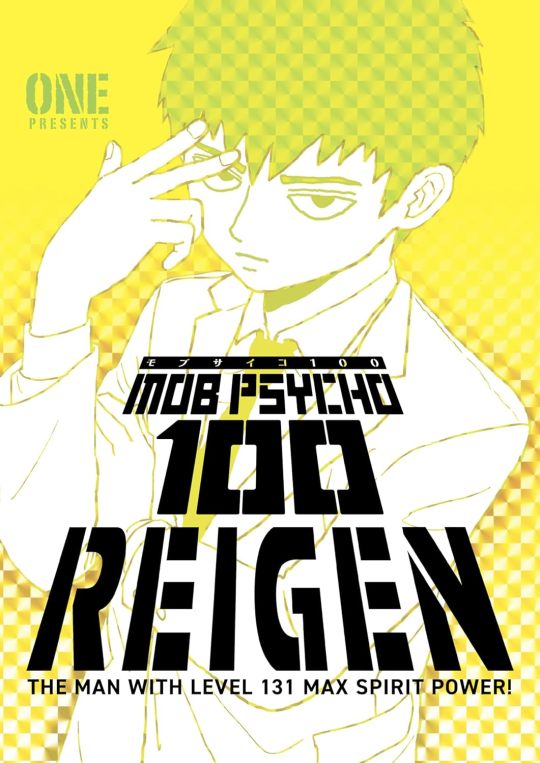
Oh, boy, oh boy. I was excited to dive into this one.
After watching the anime, which was fantastic and became a favorite of mine, I was eager to see what shenanigans Reigen and S&S would get into.
However, while there was plenty of Reigen, Serizawa, and even Dimple, always a treat, this spinoff was more of a heavy focus on Tome. I already knew that would be the case going into this, but I wasn't sure by how much.
It wasn't a bad thing, though. Those small grounding elements that she got in the anime was even more prominent here, and made her feel like much more of a character. Her eagerness to talk about the supernatural being balanced by the other more experienced characters helped with that. She's as eager as always about the occult, and she really does embody some similar qualities to Reigen.
Both dive into things recklessly and are also opportunists who can take advantage of a situation to their benefit, but still have a heart of gold underneath.
However, unlike Reigen, Tome is still very immature when it comes to the supernatural, which is more clear when in chapter 5.
A part of me doesn't blame Tome for her questions to both Serizawa and Dimple. Most people would be curious about if psychic powers could be learned and just what it means to be a spirit in the spirit world. Especially for a teenager.
However, both Serizawa and Dimple were right to call Tome out.
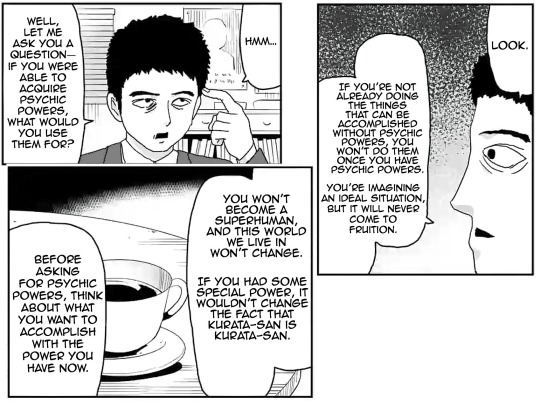

If you already won't do something that you can do without powers, why would having powers change that? What makes you think your mindset will change? Maybe it will, but do you know that for sure? On top of that, Dimple has a point in saying that Tome shouldn't complain about Dimpl's lack of knowledge, when she herself still has so much to learn about her own world, let alone a world that runs on different logic. How can she understand the spirit world without learning the basics of her own?
Even Reigen tries to get her to understand.
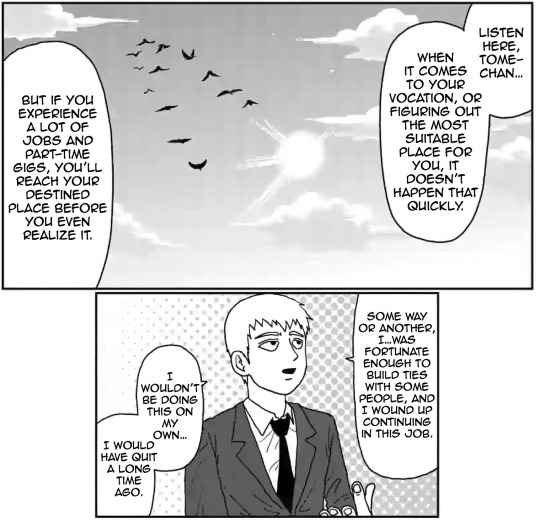
It also continues to showcase Reigen's growth as a character and I love this.
However, I can't mention the Reigen Manga without making mention of this-
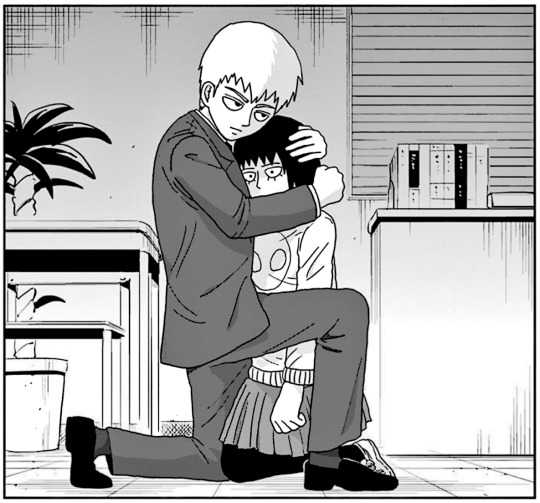
Reigen taking on the curse, running off into the forest, and ultimately tricking Rusty into getting devoured by the forest's curse. This was both very smart, but also very reckless. I both love and hate this man, lol. (And of course he'd say something about not suing for sexual harrasment. Reigen you emotionally suppressed bitch.)
Even Mob showing up right when he's needed is wonderful. I missed my boy so much, but his small inclusion was still satisfying. He sounds so exasperated when he shows up, but you just know the boy was worried for Reigen. I have no doubt he rushed over the moment he knew where to find him. That, and the dialogue right after sounds a bit like banter. Mob has come such a long way!
Of course, this was also my first time really getting acquainted with ONE's art style.
It is. . . Rough. At least compared to most other manga I've read. However, it's also not the worst that I've seen, and when comparing it to Mob Psycho Vol. 1, it's clear he's come a long way. That, and it's pretty obvious ONE tries to make his characters look pretty different from each other, which helps to remember who is who.
He's very good at making something look grotesque, too. Seriously, the way he draws certain spirits makes my stomach coil.
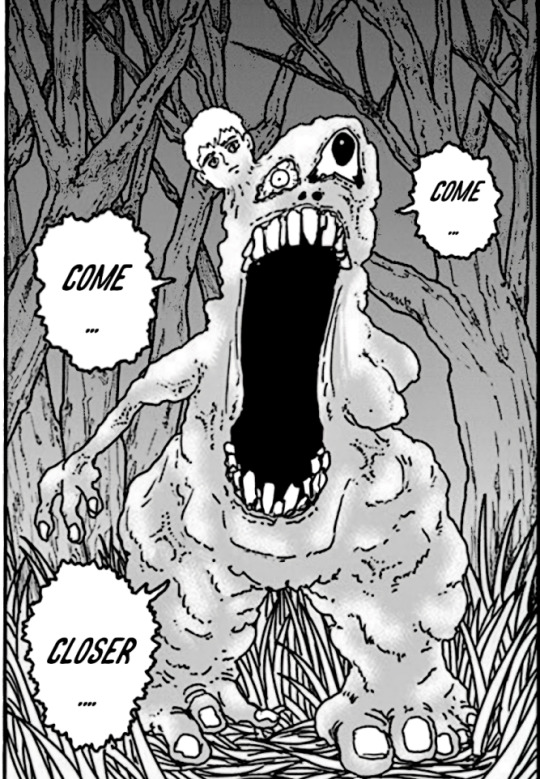
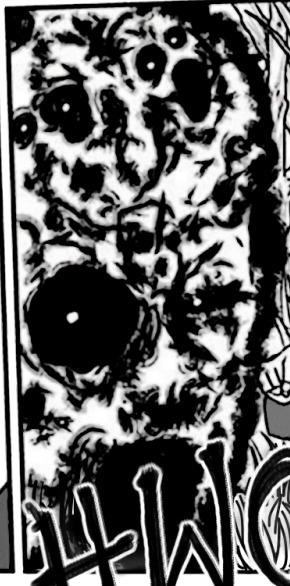
Thanks, ONE, I hate it, lmao. (Seriously, why did he have to have Reigen's head sticking out?)
Plus there were some panels where characters were drawn pretty decent too!
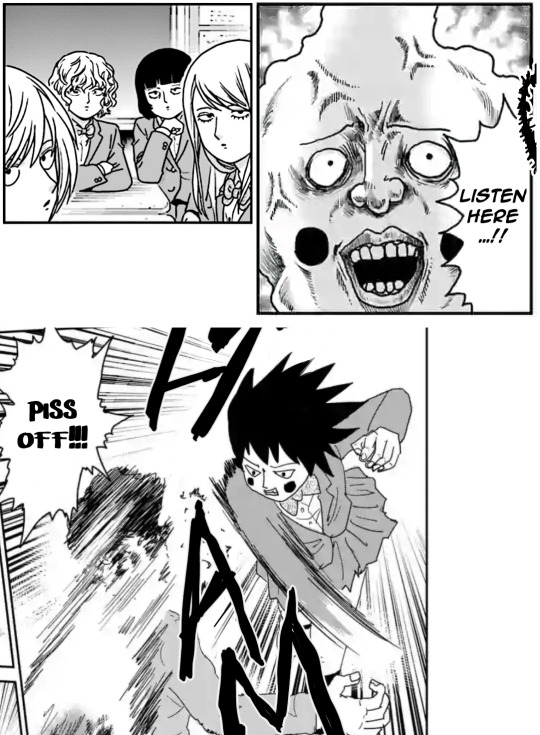
There's definitely more than this, but here's a few.
(I also hear that ONE did get some help drawing other things, mostly BGs but I don't blame him. Backgrounds can be hard, especially when trying to get the characters and the BGs to match eacother in size and perspective.)
All in all, REIGEN was a joy to read. Seeing the continued development of the characters, especially Tome, was fun. Roshuuto was a good foil to Reigen. Serizawa is really coming into his own, and Dimple just being there is always a treat for me, lol (love that asshole spirit). I doubt it will happen, but I would love to see this spinoff get animated one day. Not as a series, necessarily, but an OVA or two would be nice.
Edit: Forgot to put the scanlation credits! My bad! Found these on MangaDex.org. Scanlations by KibiDango Scans. You can also find the scans on tumblr (they also have translator's notes for why they chose the words they did which is neat!)
https://reigenscans.tumblr.com/
#mob psycho 100#mp100 reigen#reigen spinoff#tome kurata#serizawa katsuya#shigeo kageyama#mp100 dimple#roshuto dozen#mp100 roshuto#reigen arataka#manga#animanga#long post
30 notes
·
View notes
Text
Thoughts from a disabled acespec on the topic of Viktor's asexuality
As many others have discussed, I too believe the main controversy from this announcement goes hand in hand with Viktor's disability. While there are several disabled characters in Arcane, it's undeniable that he is the most prominent of them. It's an integral part of his character, his story, etc. Because of this it is undeniable that the choice of the creators to make him ace is influenced by this. And that's where the problem lies. Because it is now no longer a simple case of ace representation for the sake of ace representation. It is an inherent implication that disabled people are incapable of wanting/having sex.
This isn't anything new, either. There's a long history of disabled people being viewed as 'undesireable' or 'incapable of sex' etc. because of their disabilty. And yes, there are also many disabled people who are asexual. Whether that's because of their disability or not. And that's perfectly fine, that's real life, real people, whose decisions don't affect that of an entire fandom. But Viktor does.
If it had been any other character, I believe there wouldn't be nearly half as much uproar. Let's say Jayce, for example. The conventionally attractive himbo. Personally I think him being ace would be a way better, more subversice take, seeing as it goes directly against the 'big strong man' stereotype that he fits so easily. Seeing as Arcane breaks so many other stereotypes, why should this one be any different? And there'd still be plenty of room in the story for Jayce to have his romantic feelings towards Mel and/or Viktor. Just no sex. No big deal. He'd be asexual for the sake of simply, being asexual.
I am one of many disabled people who's seen so much of myself in Viktor's character. Which is honeslty quite rare. Yes, the ace community has a significant track record of bad representation, or even none at all. But so does the disabled community. We're in this together. I understand that seeing so much hate against this decision without the context of why it's in such bad taste is incredibly hurtful for the asexual community. But this arguement isn't all acephobia. It's ableism too. I've seen so many other disabled acespec people agreeing that Viktor's aceness is disrespectful to both communities and it's been really touching to see. We're in this together.
So, like all things in fandom, don't take it too close to heart. If you're ace and you see yourself in Viktor being ace, then that's perfectly fine. If you're disabled and are both empowered and horny by the idea of Viktor topping Jayce, hell yeah. You do you. Someone is always going to be upset and offended and very very loud about something. But never let that affect the way you choose to interpret your favs. The word of one man is not gospel to an entire fandom, no matter how important he may be.
And, frankly, I'm not going to touch the whole "oh he only said it bc he's homophobic and wants to ruin jayvik" because I do suspect that's just people blowing things out of proportion like the internet is want to do. And yes, there is definitely a portion of the fandom who has taken this announcement, and all the argueing, as a chance to just be blatantly acephobic. Like I said, that's the internet, it's bound to happen. Those people are arseholes, and do not deserve a say in this debate. This is for the queers and the cripples, amen.
(Addendum: I rarely ever make big posts like this argueing about fandom stuff, but this topic in particular is very close to my heart. Plus, I seem to be one of the few people in this discussion who is in both communities and is therefore allowed to have a proper say in all this lmao. Everything I've said here is without animosity, only to educate. Feel free to add your thoughts, or let me know if you think I missed something important. Peace and love <3)
#arcane#viktor#viktor arcane#acespec#ace discourse#I truely don't actually expect many people to read this lmaooo#just happy to be putting my two cents in
23 notes
·
View notes
Text
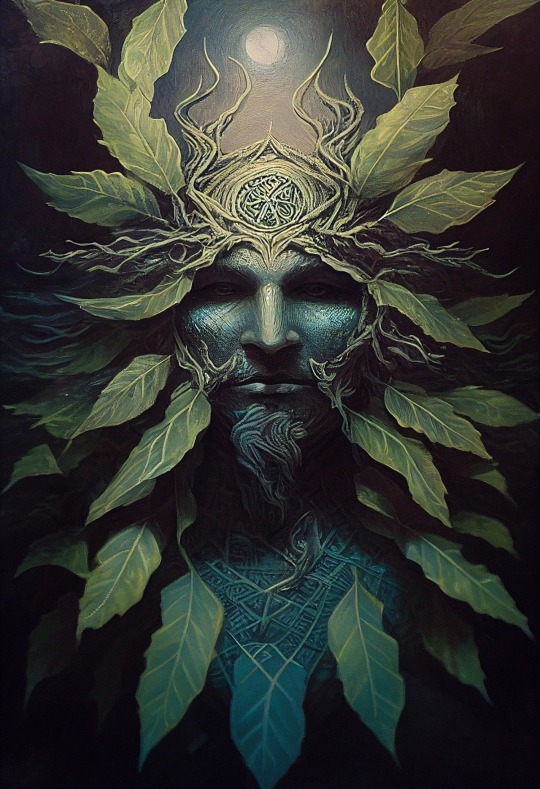

The Green Man by Talon Abraxas
Symbol of life and nature:
The most common and perhaps obvious interpretation of the Green Man is that of a pagan nature spirit, a symbol of man’s reliance on and union with nature, a symbol of the underlying life-force, and of the renewed cycle of growth each spring. In this respect, it seems likely that he has evolved from older nature deities such as the Celtic Cernunnos and the Greek Pan and Dionysus.
Some have gone so far as to make the argument that the Green Man represents a male counterpart - or son or lover or guardian - to Gaia (or the Earth Mother, or Great Goddess), a figure which has appeared throughout history in almost all cultures. In the 16th Century Cathedral at St-Bertrand de Comminges in southern France, there is even an example of a representation of a winged Earth Mother apparently giving birth to a smiling Green Man.
Because by far the most common occurrences of the Green Man are stone and wood carvings in churches, chapels, abbeys and cathedrals in Europe (particularly in Britain and France), some have seen this as evidence of the vitality of pre-Christian traditions surviving alongside, and even within, the dominant Christian mainstream. Much has been made of the boldness with which the Green Man was exhibited in early Christian churches, often appearing over main doorways, and surprisingly often in close proximity to representations of the Christ figure.
Incorporating a Green Man into the design of a medieval church or cathedral may therefore be seen as a kind of small act of faith on the part of the carver that life and fresh crops will return to the soil each spring and that the harvest will be plentiful. Pre-Christian pagan traditions and superstitions, particularly those related to nature and trees, were still a significant influence in early medieval times, as exemplified by the planting of yew trees (a prominent pagan symbol) in churchyards, and the maintenance of ancient “sacred groves” of trees.
Tree worship goes back into the prehistory of many of the cultures that directly influenced the people of Western Europe, not least the Greco-Roman and the Celtic, which is no great surprise when one considers that much of the continent of Europe was covered with vast forests in antiquity. It is perhaps also understandable that there are concentrations of Green Men in the churches of regions where there were large stretches of relict forests in ancient times, such as in Devon and Somerset, Yorkshire and the Midlands in England. The human-like attributes of trees (trunk-body, branches-arms, twigs-fingers, sap-blood), as well as their strength, beauty and longevity, make them an obvious subject for ancient worship. The Green Man can be seen as a continuing symbol of such beliefs, in much the same way as the later May Day pageants of the Early Modern period, many of which were led by the related figure of Jack-in-the-Green.
Symbol of fertility:
Although the Green Man is most often associated with spring, May Day, etc, there are also several examples which exhibit a more autumnal cast to the figure. For example, some Green Men prominently incorporate pairs of acorns into their designs (there is a good example in King's College Chapel, Cambridge), a motif which clearly has no springtime associations. In the same way, hawthorn leaves frequently appear on English Green Men (such as the famous one at Sutton Benger), and they are often accompanied by autumn berries rather than spring flowers. The Green Man in the Chapelle de Bauffremont in Dijon (one of the few to retain its original paint coloration) shows quite clearly its leaves in their autumn colours.
This may have been simple artistic license. However, acorns, partly due to their shape, were also a common medieval fertility symbol, and hawthorn is another tree which was explicitly associated with sexuality, all of which perhaps suggests a stronger link with fertility, as well as with harvest-time.
Symbol of death and rebirth:
The disgorging Green Man, sprouting vegetation from his orifices, may also be seen as a memento mori, or a reminder of the death that await all men, as well as a Pagan representation of resurrection and rebirth, as new life naturally springs out of our human remains. The Greek and Roman god Dionysus/Bacchus, often suggested as an early precursor of the Green Man, was also associated with death and rebirth in his parallel guise as Okeanus.
Several of the ancient Celtic demigods, Bran the Blessed being one of the best known, become prophetic oracles once their heads had been cut off (another variant on the theme of death and resurrection) and, although these figures were not traditionally represented as decorated with leaves, there may be a link between them and the later stand-alone Green Man heads.
There are several examples of self-consciously skull-like Green Men, with vegetation sprouting from eye-sockets, although these are more likely to be found on tombstones than as decoration in churches (good examples can be seen at Shebbear and Black Torrington in Devon, England). Such images might be interpreted as either representing rebirth and resurrection (in that the new life is growing out of death), or they might represent death and corruption (with the leaves growing parasitically through the decaying body).
The Green Man as archetype:
The very fact that images of the Green Man have appeared historically in such disparate and apparently unconnected locations have led some commentators, notably Roweena Pattee Kryder and William Anderson, to suggest that the figure is part of our collective unconscious, and represents a primeval archetype (in Jungian parlance) which is central to our relationship with Nature.
Phyllis Araneo has suggested that the appearance of the Green Man in European and worldwide art is a cyclical phenomenon triggered by times of crisis or significant change. For example, she suggests the proliferation of Green Man imagery after the 11th Century can perhaps be associated with feelings of relief and celebration after the widely predicted apocalypse of the millennium failed to materialize.
In the same way, the modern resurgence may have been triggered by the environmental crisis we are currently living through. In its modern revival, in the wake of James Lovelock’s Gaia Hypothesis and the birth of the modern Green movement, the Green Man can be seen as the archetype of the “conservator”, whose brief is to counsel us to take from the environment only what we need to survive and to conserve the rest, and to remind us of our responsibilities for the stewardship of the natural world. A quote from Mike Harding succinctly summarizes this position: “If anything on this poisoned planet gives us hope of renewal it is this simple foliate head that has been there in one form or another since the beginning.”
-The Enigma of the Green Man - Theories and Interpretations
44 notes
·
View notes
Text
MR5: Why is data crucial in the discussion surrounding mental health/criminal justice system?

Justice-Involved Mental Illness- History
Mental health and mental illness has always proven to be a difficult topic to tackle, often with the symptoms being more invisible and neglected, and this is even more the case when it comes to offenders and others involved in the criminal justice system.
The most prominent difficulties are: diagnoses relying on full cooperation, many of the justice-involved population feigning mental issues, and a vast difference in screening practices and how professionals diagnose people over time passing and geographical area (Hector & Khey, 2022).
The types of data collection within this subfield are also more dispersed than uniform. Population surveys try to take a representative sample of the entire population to make generalizations; health care surveys come directly from healthcare and insurance providers, using both the Statistical Manual of Mental Disorders and the International Statistical Classification of Diseases and Related Health Problems; vital statistics are those including and relating to births, deaths, marriages and divorces, with the focus on deaths when discussing mental health.
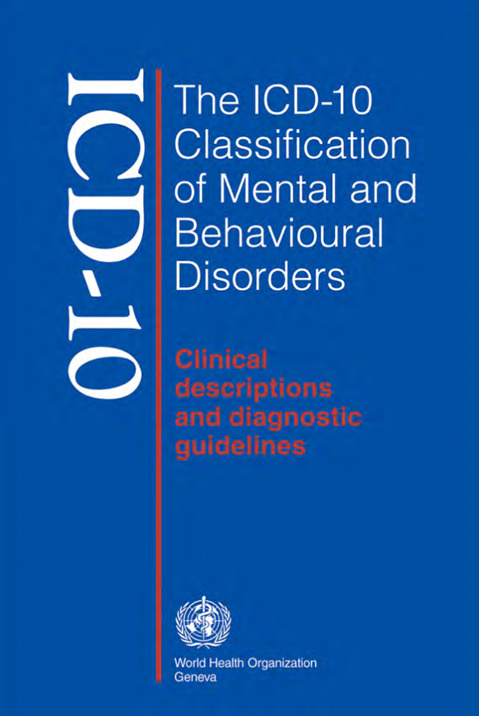
Data Importance
Without data, we cannot navigate through what to do with policy implications, whether it be if it is needed or not, or where to allocate the resources to most efficiently help those justice-involved individuals with mental health problems. Existing data can show the statistics for how many justice-involved individuals have mental health history, and based on that, we can develop policies to target it, and see the effectiveness of the policies, also through data.


For example, the Substance Abuse and Mental Health Services Administration (2023) has plenty of data on the percentage of different demographic characteristics in relation to their struggles with mental health and their treatment, which we can use to implement policies to make treatment more accessible to those with mental illness.
References:
Hector, J. & Khey, D. (2022). Criminal Justice and Mental Health: An Overview for Students. 2nd Edition. Springer Publishing. ISBN: 978-3-031-15337-2
Substance Abuse and Mental Health Services Administration. (2023). Key substance use and mental health indicators in the United States: Results from the 2022 National Survey on Drug Use and Health (HHS Publication No. PEP23-07-01-006, NSDUH Series H-58). Center for Behavioral Health Statistics and Quality, Substance Abuse and Mental Health Services Administration. https://www.samhsa.gov/data/report/2022-nsduh-annual-national-report
12 notes
·
View notes
Text



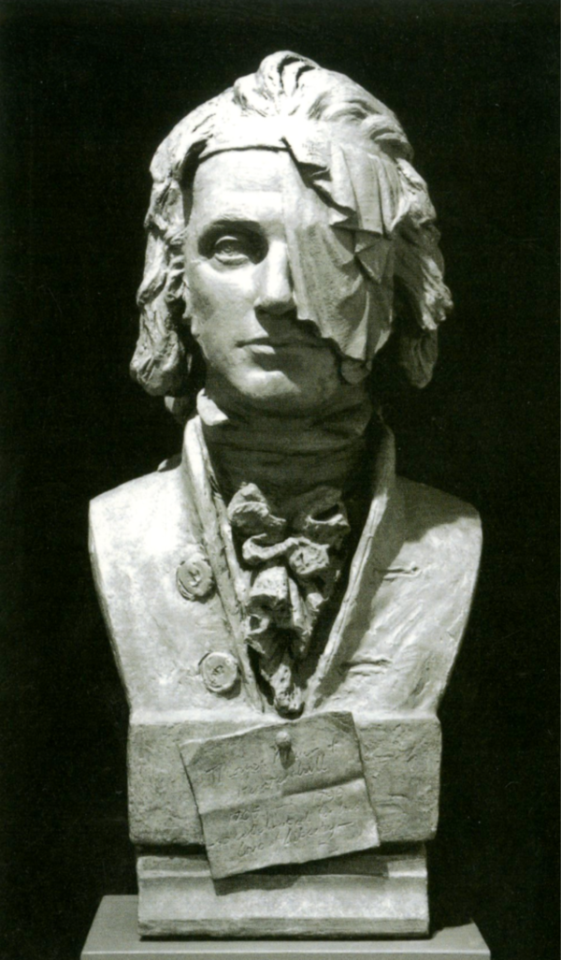
On 2nd January 1793: Thomas Muir of Huntershill, the Glasgow-born Advocate, was arrested for sedition.
He was released after a few days and went to France. On his return to Scotland, Muir was tried and sentenced to 14 years transportation. Muir was the founder of the Scottish Friends of the People, he and the other leaders of this group transported to Australia, are known as the Scottish Martyrs
Thomas Muir and his companions in misfortune, who later became famous as the Scottish Martyrs, were among the prominent figures of the vast movement for reform that emerged in Britain at the end of the eighteenth century. What makes their case particularly interesting is that these men were sentenced to transportation, a form of exile that needs to be included in any consideration of the themes of exile and return. Drawing on the example of Thomas Muir, this article will investigate the specific nature of political exile. Does the “time” (in the sense of temporality) of political exile differentiate itself from the “time” of other forms of exile? Is political exile characterized by a state of “fundamental discontinuity”?1 Does the political, intellectual or ideological dimension of political exiles enable them overcome, maybe more than other exiles, the essential sadness of exile? These are some of the questions I propose to address in this paper.
In the seventeenth century the English and Scottish governments viewed the colonies, for example America, as perfectly appropriate places to send miscreants of all kinds, criminals, vagrants, prostitutes or political prisoners. Transportation constituted an instrument of social control whose function was to deter people from resorting to criminal acts. Andrew Fletcher of Saltoun, who was one of the most determined opponents of the Union of 1707, thought, like many of his contemporaries, that the system of transportation was the panacea for solving the endemic problem of vagrancy:
There are at this day in Scotland two hundred thousand people in Scotland begging from door to door. These are not only no way advantageous, but a very grievous burden to so poor a country in all times there have been about one hundred thousand of those vagabonds who have lived without any regard or subjection either to the laws of the land or even those of God or nature in years of plenty many thousands of them meet together in the mountains, where they feast and riot for many days; and at country weddings, markets, burials, and other the like publick occasions they are to be seen both men and women perpetually drunk, cursing, blaspheming and fighting together. These are such outrageous disorders, that it were better for the nation they were sold to the gallies or West Indies, than that they should continue to be a burden and like upon us
In recent years there have come to light an increasing number of writings by Thomas Muir of Huntershill. Among these is Muir’s legal thesis on the topic of slavery that criticized the institution and condemned it as morally unjustifiable it was written for admittance to the Faculty of Advocates in Edinburgh in 1787 and can be found in the holdings of the National Library of Scotland.
16 notes
·
View notes
Text
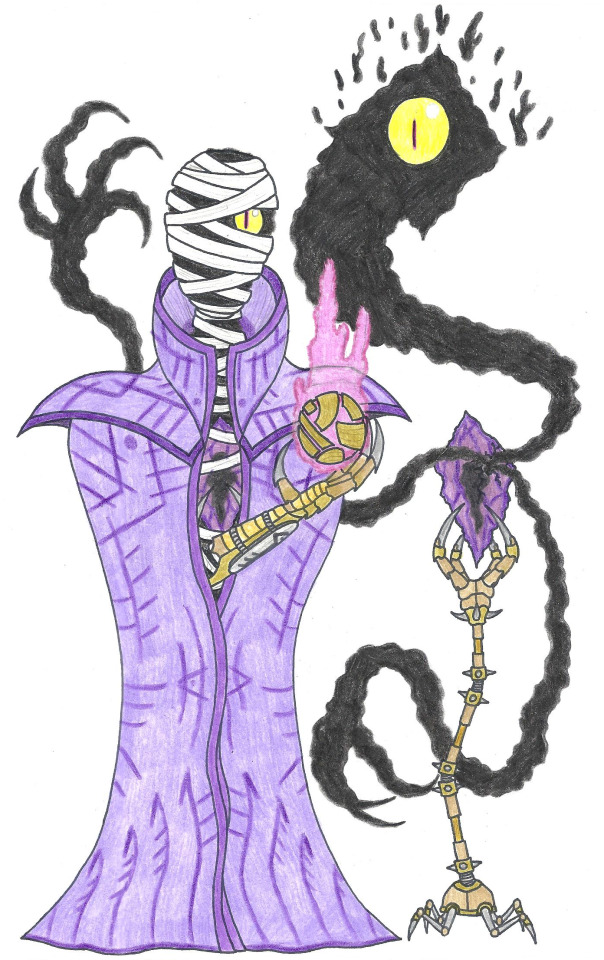
When you ask the common folk what they think about magic users, you usually get one of two answers. There are those who see the benefits that come from the likes of mages and witches, where magic grants incredible blessings and abilities to make life easier. Some may cite the magical barriers that protect cities during a siege, or the wielding of elements to tame nature and destroy evil, and of course one cannot forget the incredible healing that can come from it. There is no denying that magic brings many a boon to the people, but that doesn't mean folks have to like those who wield it. The other answer you will get is that magic users are a dangerous and insufferable lot. Folks will point to mages and grumble about their smugness and sense of superiority, recalling how such groups use these powers for their own benefit. To them, magic gives one an inflated ego and the permission to do whatever they want, as kings and authorities will happily give leniency as long as it means having a magic wielder on their side. Of course, both of these opinions are highly generalized, as magic can do both good and bad. While there are indeed prominent examples of mages and the like using their powers for selfish reasons, there are plenty of good folk out there that let this blessing benefit all. Fine upstanding citizens that realize their power and talent should be used for the betterment of mankind. Unfortunately, Englorian Shaid is not one of those people.
Ever since Englorian Shaid awakened his ties to magic, he has viewed it as a power that inherently made him better than everyone else. It didn't help that this connection to these arts came from his bloodline, passed down from powerful ancestors to him. Being a descendant of such potent mages and sorcerers, like Cavarious Shaid, gave Englorian this sense of superiority. Thus, he was (and still is) a smug condescending sorcerer that feels that magical might gives divine right. His powers are that of a master, so who would dare to tell him no? If he can blast his way through his enemies and silence anyone detractors, then why should he bother to abide by their useless words and laws? This belief made Englorian very few friends and a ton of enemies, yet they could not stop him. His bloodline gave him staggering control over various types of magic, and on top of all that was the beloved collection that he inherited. The Shaid family was filled with rabid collectors of magical artifacts, weapons and trinkets, gathering a horde that makes entire guilds envious. With access to all this, Englorian proved to be a menace that was difficult to defeat. Not only that, but it infected him with the same need as his ancestors: to expand the great Shaid collection.
Englorian Shaid will do just about anything to add a new addition to the massive collection, and it was this that made him such a menace. Any magical bauble that caught his eye would cause problems for those who owned it. It didn't matter if this artifact had a different master, Englorian wouldn't stop til he had it in his hands. Be it an academy, museum or temple, he would happily blast his way through walls, guards and lock boxes to obtain his prize. He robbed many and fried even more, as he often needed to be sure this new toy was the real deal. Commoners who lived near his manor would be given the honor of being target practice, and any who gave him lip would be added to the shooting range. Englorian didn't see anything wrong with this, as it wasn't like they were important or anything. Cripes, they breed like rabbits, there will always be more of them. But of course, such actions could not be ignored, and he faced quite a few warriors, mages and assassins that wished to bring his reign of terror to an end. Most of them perished in spectacular ways, but Englorian's streak would not last forever. Sometimes, all it takes is for one lucky move to bring it all crumbling down.
One fateful day, Englorian Shaid found his manor besieged by a team of heroes. This didn't bother him much, as he had killed plenty just like them. When they challenged him, he wasted no time in unleashing his power. The battle that ensued was great, with his incredible magic crashing against the warriors and threatening to vaporize them. To Englorian, victory was assured, it was only a matter of time before their defenses finally failed. However, the team had a trick up their sleeve, and unveiled a magical crystal that Englorian had not seen before. This battle had been nothing more than an attempt to get close enough to the sorcerer to activate it, and when it was awakened, he could do nothing to stop what was coming. The crystal was a hungry container for magic, and the boastful sorcerer whose body was steeped in it was a prime meal. Englorian found his very essence torn from his body and sucked into the artifact, where it would be locked away. As his body crumbled to dust, his soul was alive and conscious within this crystalline prison. This would be the end of the greedy sorcerer, befalling an ironic fate of becoming a fine addition to someone else's collection. Or that was what should have happened...
For years, Shaid was trapped in this crystal and held as a trophy, but luck would eventually free him. His automaton assistant, Kree-Tal, would at last pull off a plan to break into the collection and swipe his master from his pedestal. This prison would be carried back to a secret safehouse, where Kree-Tal and Englorian's mind would work to free him from the crystal. He still was a potent magic user, and this safehouse contained a chunk of the family's collection. No doubt this would solve the riddle of this wretched crystal and free his soul! Many attempts were made, but none succeeded in truly breaking him free. To Englorian's frustration and misery, he could not fully escape this artifact. Whatever magic they had used to bind him, it was far more archaic and ancient than he could manage. The only thing their efforts succeeded in was cracking the crystal just enough for a part of his essence to leak out. It wasn't true freedom, but it did allow him to create a shadowy form that could act has a crude body. In a way, Englorian was back, just not in the flesh.
Shaid's return would have been a triumphant one, if anyone cared. As it turns out, being sealed away in a crystal for decades and stored in a dusty trophy room caused most people to forget you even existed. Enough time had passed that his legacy had faded, and many of his possessions had been absconded with. To Englorian's horror, much of the family's collection had been seized and scattered, his defeat opening the vaults to collectors and looters alike. The hideaway tower Kree-Tal had carried him to was one of the few pieces that had been missed. He still retained many artifacts and weapons, but it hardly mattered compared to what had been lost. Once Englorian gained this shadowy form, he made it his priority to reclaim what had been stolen from him, and rebuild the collection back to its former glory.
Though his flesh is gone, Englorian still retained his magical prowess, wielding it now with his shadowy limbs. This ethereal nature turned out to have some benefits, as he is no longer restricted by the human body. He can summon forth multiple hands to unleash spells with, and most other magic passes harmlessly through his darkness. Since the crystal still contains his soul, he cannot truly part from it, but some clever tinkering has granted a moveable pedestal that can cart this prison around. With this, he can travel about on his quest to reclaim the stolen heritage that his family so rightfully hoarded, using spells and artifacts to enact his vengeance. With how adaptable his new body is, Englorian was pretty thrilled with the possibilities. See how he can summon as many limbs as he needs, and how his foes cower at his phantom visage! Plus, since he is no longer bound by flesh, he has no need for eat, drink or sleep! No reason to stop, no reason to slow down! His pursuit for his heirlooms never has to cease, his painstaking curation of his remaining collection can continue without pause! It is great! Freeing! Limitless! Well, until the luster of it all started to fade...
While Englorian originally found this new form to have perks, the novelty of it started to wear off with time. Yes, his form could take any shape and he no longer needed the necessities of life, but there were parts of that he began to miss. He was no longer bothered by hunger or thirst, but what about the taste of his favorite meals? What about the beautiful aroma of a fine wine? Even when in this shadowy form, focused on his mission of retrieval, he couldn't shake away these wants. Eating food was great, drinking wine was wonderful! Even the peace of sleep was eventually missed, as Englorian started to feel bored with the nonstop nature of it all. While he had the basic senses needed to interact with the world around him, frivolous things like smell, taste and touch were lost with his ethereal nature. They didn't seem like much then, but now their absence gnaws at him. To the point where he has started to get a little desperate.
If one were to watch Englorian in his home, they may wonder if he has truly lost these senses. While he meticulously maintains and cleans his collection, he will sneeze at the dust and even give out heavy sighs of hard work done. Kree-Tal will be in the kitchen cooking dinner, and Shaid will be sure to comment on how it is smelling great. And at the end of the day, a meal shall be presented with a bottle of wine, which the shadowy sorcerer will relish. He savors his food as he talks about the flavor and texture, making sure to note the aroma and hints found within his favorite drink. Once that is done, he heads to bed so that he may rest for the next day. How can this be, when he claims to not have these needs or senses? The reason is simple, and a bit worrying: he's making it all up. Though he doesn't breath, he does pretend to, faking the sound of being winded after heavy lifting and letting out a clearly staged sneeze when he notes a cloud of dust. He cannot smell or taste, but he calls upon memories of the sensations and uses that to act it out. Even if he could smell, there is no odor to enjoy, as Kree-Tal's "cooking" is also an illusion. Since Englorian cannot eat food or drink fluids, using actual ingredients would be a useless waste, thus props are used. His "dinner" is nothing more than wood shavings, wax and clay, all shaped to look like a proper meal. His "wine" is just dyed water, yet he acts as if it is a fine vintage. Eating is actually just dropping the false morsels into his shadow form, approximately where a mouth would be. Though he "chews" and "savors," the stuff really just falls through him and onto the floor. Kree-Tal then simply cleans up the mess as Englorian heads to his room to "power down." What he gets from all this is nothing, just the illusion that he is still somewhat human, even if it makes him look crazy. Especially when people learn that his form cannot do things like clap or snap his fingers, so Englorian makes up for it by just making the noise himself as he does the gesture. It's...kinda weird...
These simple wants have slowly built up over time into something very obvious to him and everyone else. One just needs to look at the disguises he puts on over his shadow form and crystal podium to see that he wants a new body. For now, he uses cloaks and gauntlets to drape over a bandaged silhouette, creating the illusion of a person. But to get the desired sensations back, he needs new flesh and blood. To do so, he needs two things: the right magic to free him from the crystal and a proper body for him to take over. The spell needed to destroy this prison is still a struggle to find, but he imagines that sooner or later his pursuit for magical relics will reveal the answer. Thus, the other thing to worry about is finding a good body to make his own. Now that he doesn't have to rely on what he was born with, he can afford to be picky. For a infamous sorcerer like himself, not just any meager flesh will do! In fact, Englorian is starting to wonder if he has to settle for a mere human at this point. This thought has arisen in his mind ever since he ran into a weird little group of freaks, a bizarre collection of creatures who call themselves "knights" for some reason...
Englorian Shaid crossed paths with the Knights of the Wrong Table during his quest to steal back his relics, the pesky do-gooders barging into his business whenever he was sacking a museum or sacred temple. After the fools somehow managed to deny him his prize on a few occasions, he started to develop a grudge against them. But then, after taking a closer look at their roster, he started to get some ideas. Yes, they needed to be destroyed so they would stop bothering him, but perhaps something of use could be salvaged from these fools. A human body is fine and all for him to steal, but what about a demon, or a dryad, or a fairy? Hells, what about a DRAGON?! Now Shaid is looking at the Wrong Table like how one would eye a sampler platter, trying to figure out a favorite to take from the group. Of course, it is so hard to choose sometimes, the sorcerer constantly changing his mind on which body he would like to steal. Some days he might think a slime could make a good host, while others has him considering the form and strength of a giant ant. This results in Shaid's conflicts with the Wrong Table sometimes veering into kidnapping and possession, looking to try out one of these bodies as if they were a new shirt. Thankfully, since Shaid has yet to discover a way to sever his bonds to his crystal, such possessions are temporary and can be disrupted. Typically, it calls for targeting his crystal, as it is the one part of his form that can take damage. One would think that hitting his crystalline prison would free him, but he's already tried that. In fact, he worries that destroying this relic would wind up shattering his essence as well, essentially killing him. Thus, he has to begrudgingly protect the very thing that shackles him.
Battles against Englorian are tough ones for the Knights of the Wrong Table, mainly due to his magical prowess and the fact the knights have zero of that stuff. Thus, they have to try and fight an annoyed sorcerer with nothing but their blades and wits. Shaid's ability to summon different elemental magic lets him take advantage of each member's weakness, and crafty use of his collected artifacts lets him unleash new and terrible spells. Yet, the order has learned ways to take on this shadowy figure. One is his crystal heart, which is the main way to damage him or interrupt his spells. While blades and arrows phase right through his dark limbs, a solid hit to the crystal seems to frazzle his essence for a few moments, causing magic to fail and his hands to lose consistency. The second weakness of his is his precious collection, as it is his pride, joy and inheritance. While he may use some of the weapons within, he is loath for any harm to come to them. In many cases, he will put himself into danger to prevent a valuable piece from getting damaged, so targeting his beloved artifacts are a good way to upset him. One must be careful, though, as if his anger grows too much, he may abandon his false humanoid form in a rage and transform into a terrible shadowy fury, unleashing hell like a dark magic wielding spider.
But sometimes the biggest weakness of all is Englorian's partnership with King Olaf the Seventh. Though the shadow sorcerer thinks the puppet king is an absolute idiot, the tempting secrets of his Stitched Manuscript are too good to pass up. By siding with Olaf, Shaid gets access to the enigmatic tome in hopes of translating it and figuring out the spells within. He feels confident that the magic needed to free his soul and transfer his essence can be found within, he just needs to crack the code. And also suffer Olaf's irritating presence and obnoxious attitude. The blithering king constantly demands the use of Shaid's magic, as well as access to his collection of magical weapons. He thinks he knows how to handle them, but Englorian would rather give these precious relics to crazed toddler than hand them over to that patchwork fool. But he must aid Olaf if he wants access to that tome, so he must find ways to placate the puppet while also keeping his collection safe. And even if they do work as a (somewhat) team, you can be sure that there will be constant bickering between the two, as each one accuses the other of being an unbearable and egotistical moron.
----------------------------
Remember waaaaay back when when I said i was going to update the Knights of the Wrong Table roster? I was speaking truth, but it just so happened to be very very delayed! Old watchers may recognize this fellow but be puzzled by the name. Indeed, I did change his name a bit, because the old one was stupid. Is this new one still stupid? Probably, but I like it better.
9 notes
·
View notes
Note
Everyone says Three Houses has the best story, but I couldn't disagree anymore than I already do because that game somehow did all 3 of my biggest writing pet peeves
To make matters worse, they did the one I hate the most three separate times
Not knowing you or your peeves, I'm not going to guess at what those are.
But too often this fandom seems to conflate having good writing with being good for fanwork* which are indeed very different things. See, as a prominent example, Supernatural: the bedrock of Tumblr fandom culture, based on (by all accounts) a thoroughly mediocre TV show. Disjointed messes are playgrounds for fandom, and Three Houses's writing has plenty of gaps in it that are ripe for exploration in fanwork. It also comes with a malleable and somewhat relatable premise - the special school setting with the prominent branding, the same thing that helped make Harry Potter big - that fans can easily adapt however they choose, and that IS loves to plug as the most prominent element of the game's legacy.
All the same, that there are still people arguing over basic plot points over half a decade after the game came out does not speak to its writing quality. If it eases your frustration, pretty much everyone who still claims that FE16 is well-written would actually agree that it isn't....provided they're talking about the routes they don't like which for some reason aren't counted against the game's overall writing quality.
*I imagine at least some of this stems from curatorial fandom and its impulse to catalogue and justify the quality of canon, in contrast with transformative fandom which grows out of dissatisfaction with the failures of canon. Yes, oftentimes those failures can be summed up as "needs more/better sex," but a failure is a failure.
15 notes
·
View notes